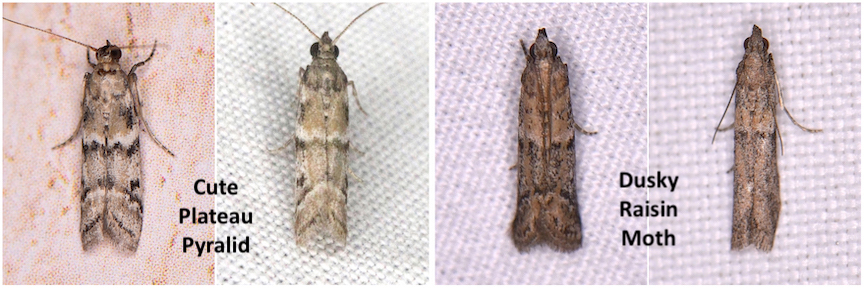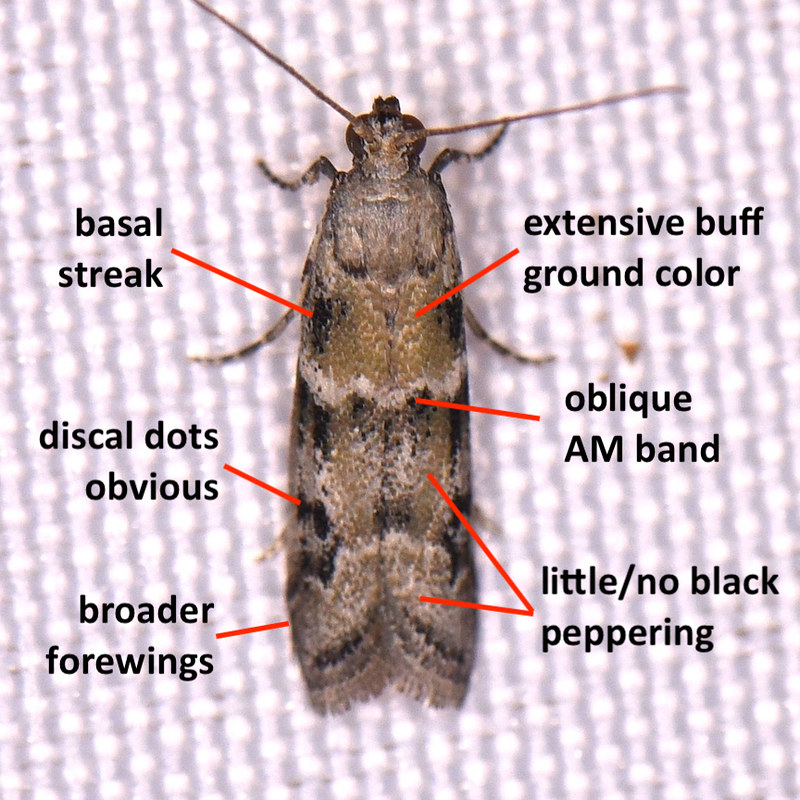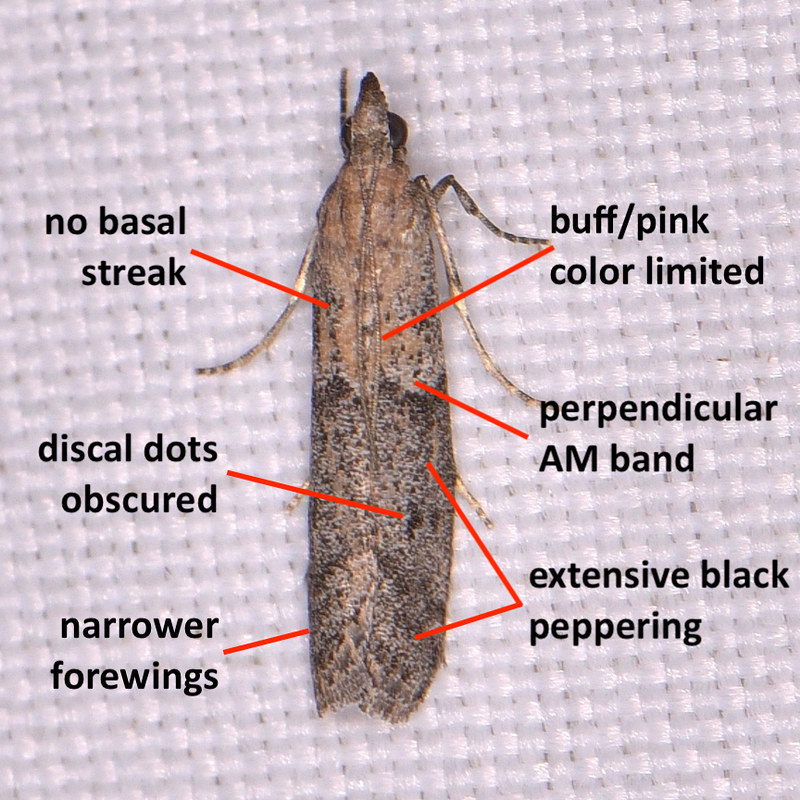Identifying a Texas Endemic Phycitine Pyralid Moth
Several of us recently attended a special mothing event April 15 at the Snowden Tract of Travis County's Balcones Canyonlands Preserves in NW Austin. The mothing was very good (around 200 species IDed so far), including many individuals of a small Phycitine Pyralid that had us scratching our collective heads. @jcochran706 did some sleuthing and pointed us towards some BOLD images of a Central Texas endemic that has been "rarely collected" (Neunzig, MONA fasc. 15.3, p. 68): Ephestiodes mignonella. The Moth Photographers’ Group page for the species, at this writing, has no images but I’ve written Steve Nanz to invite him to add some of our recent discoveries. BugGuide currently has no page for the species, a situation which should change soon.
For purposes of the present discussion, I am going to coin a somewhat whimsical common name for this species, the “Cute Plateau Pyralid”. If you’re curious, this is based not only on the geography of the species (confined primarily to the Edwards Plateau of Texas) but also on the first English word suggested by Google Translate for the base term “mignon” in French. The original authors of the genera Ephestia and Ephestiodes were French, and although Harrison Dyar, author of Ephestiodes mignonella, did not state as much, he was probably naming the species based on a Latinized derivative of the French word. So “CPP” it is, for the time being. This link will give you the array of presently-identified examples of CPP on iNaturalist.

Photo Credits: 1st, 3rd, & 4th by @jcochran706, Williamson Co., TX; 2nd by @amzapp, Edwards Co., TX

Photo Credits: Both by @jcochran706, Willliamson Co., TX.
The Cute Plateau Pyralid is a close relative of the abundant (and over-identified) Dusky Raisin Moth (Ephestiodes gilvescentella; hereafter DRM). Many of the images of CPP on iNat were either mis-IDed by iNat’s Computer Vision as DRM, labelled inaccurately by observers, or just placed understandably as “Phycitinae”. After reviewing the BOLD images, rereading Neunzig's account of the species, and studying about 40 to 50 images on iNaturalist, I've compiled the following notes on how to separate CPP from DRM.
As we understand the taxon, the CPP is a central Texas endemic (type locality: Kerrville, TX), found mainly in the eastern and southern portions of the Edwards Plateau, with records from Hamilton County south and west to Edwards County. Neunzig mentioned that the species has a limited flight season in the early Spring. Dates of the available set of images range from March 16 to May 14, with the vast majority occuring from mid-April to early May.


Left: Cute Plateau Pyralid, E. mignonella. Right: Dusky Raisin Moth, E. gilvescentella
Photo Credits: Both images by @jcochran706, Williamson Co., TX. Left: 11 April 2021, Right: 31 March 2023.
Summary: Identifying CPP: Compared to the DRM, the forewings (FWs) of CPP are proportionally wider and the FW apex more acute and outer margin more oblique. The buff ground color of CPP is more apparent due to a lighter peppering of black scales, rendering other lines and marks more obvious and crisper. Both the antemedial (AM) and postmedian (PM) lines of CPP are crisper and usually more complete than on DRM. The AM line on CPP appears more oblique; that of DRM closer to perpendicular. CPP usually has a distinct black post-basal patch or streak, lacking or not obvious on DRM. The heavy black overscaling of DRM can blend with the black shading on the AM and PM lines and is especially heavy in the median and subterminal areas of the FW.
Detailed Comparison: CPP is similar to DRM but its shape is quite different: The forewings are proportionally broader and not as parallel-sided. The FW apex is slightly acute and the outer margin is inwardly oblique to the tornal angle, contrasting with the squared to evenly rounded FW apex and outer margin of DRM. Most of the thorax and FWs have a distinctive buff-gray to pale olive-gray ground color similar to DRM, but all markings are more distinct, lacking most of the peppering of black scales of DRM. CPP usually has an obvious post-basal black streak, blotch, or spot occupying the middle of the basal 1/3 of the FW. This can take the form of an irregular black patch or might be reduced to a narrow rectangular streak. By contrast, DRM may have a scattering of black scales in the basal 1/3 of the FW but these rarely coalesce into anything resembling a patch or streak.
The white and black AM bands provide an important distinction between these two species. On both species the white AM line comes off the costal margin slightly distally oblique. On DRM, this white line curves or bends abruptly to reach the inner margin nearly perpendicular. The overall effect is of a relatively perpendicular or slightly (distally) bowed AM line. On about half of the images on iNat, this white line may have a very short distal turn at the inner margin but the overall effect is minor, still leaving the overall line looking mostly perpendicular. By contrast, most examples of CPP have the white AM line with a double zig-zag and meeting the inner margin at an outwardly oblique angle, thus giving the whole AM line an oblique look. There is quite a bit of variation in this line on the two species but basically, the AM line is more perpendicular on DRM and appears more jagged and oblique on CPP.
The black shading on the distal side of the white AM band differs recognizably in the two species. On CPP, the black shading is relatively crisp and complete from costal to inner margin. It is not usually broken by buff streaks as frequently seen on DRM. The rear edge of this black shading, while not crisply defined, is far less blurred than that typically seen on DRM. On the latter species, this post-AM line black shading is blurry and diffuse, sometimes broken into two or three separate black blotches which blur rearward into the heavily salt-and-pepper median area of the FW. In the median space on CPP, the black discal dots are bold, standing out on the mixed white and buff ground color which has only a slight admixture of black scales. On DRM, the median area is heavily peppered with black scales often obscuring the discal dots to a greater or lesser degree.
The inwardly oblique black and white PM line is fairly similar on both species but it shows up much more crisply on CPP due to the lack of black overscaling. On CPP, the white PM line is completely lined by black on the basal side and by brown on the distal edge. On DRM, the peppering of black scales in the post-PM line area can be light to heavy, generally rendering the PM line less distinct.
Both species have a terminal row of black dots which may be separate or coalesce into a black terminal line.
A caveat to this whole account is that we have not yet had any specimens from the Austin area checked for genitalic or DNA confirmation of the identity we’re placing on them. Local moth-ers are encouraged to collect a few of these and preserve them so we might send them off to a qualified expert for such determinations.





Comments
So, the thumbnail photo for Ephestiodes gilviscentella on MPG could be a mis-ID then? It looks like what we are calling E. mignonella. None of the other photos there look like that thumbnail, though.
https://mothphotographersgroup.msstate.edu/fast.php?plate=13.1&page=12&size=s&sort=h
Good point, Rich. I'm not sure. It would be useful to find out when/where Jim Moore's photos on the MPG page was taken. If it was in the Edwards Plateau in the Spring, I wouldn't hesitate to re-identify that one image as mignonella.
@steve_nanz ?
http://mothphotographersgroup.msstate.edu/species.php?hodges=6000
Workin' on it. I can tell you that Jim Moore's specimens are from Lassen Co., CA. The MPG photo came from his BugGuide submission #397746. The ID was based on similarity to his BG 578294 which was barcoded, however, I have not been able to track it down at BOLD.
Got it. Jim's MPG image, BG 397746 is BOLD JMMMB073-11 in BIN BOLD:AAA2650, the BIN for gilvescentella (over 600 specimens) which includes Ann Hendrickson's similar TXLEP1024-20. Both look more like what you show as mignonella at least in the dorsal view. In lateral view, they look like your gilvescentella.
So Jim's MPG image should be good. You may want to tweak your descriptions.
The are 7 specimens at BOLD identified as mignonella. None are barcoded. How are you using BOLD to ID that species? What barcoded specimens as BOLD are you calling mignonella? Fortunately, CCDB-29002-D06, CCDB-29002-D07 and CCDB-29002-D08 are "paralectotypes", so I do not question those.
Steve, sorry to be a bit slow to respond to your question. I was examining the five publicly visible specimens of mignonella on the BOLD website which as you mention include 3 paralectotypes plus additional specimens from Kerr and Blanco counties.
https://v3.boldsystems.org/index.php/Taxbrowser_Taxonpage?taxid=727150
All of those present a consistent pattern as I describe above. I think Ann's Edwards County specimen that you link to above looks to my eye like a standard example of gilvescentella, so it should predictably fall into the BOLD BIN for that species. I hope we can get some barcoding done in the future on suspected CPP's!
Great work identifying this little endemic! I like the "Cute Plateau Pyralid" common name. Do you know how to add it in iNaturalist?
@zdufran
Hi Zach:
I'm not sure if you're asking a functionality question, or whether Ephestiodes mignonella has been added as a taxon to iNaturalist. If the former, I always ask somebody else to do it, like Chuck or Sam K. I guess you could say I find it very easy to add a taxon to iNaturalist, LOL. If the latter, the "new" moth has indeed been added as a taxon to iNaturalist. You can find its page here:
https://www.inaturalist.org/taxa/346500-Ephestiodes-mignonella
Add a Comment